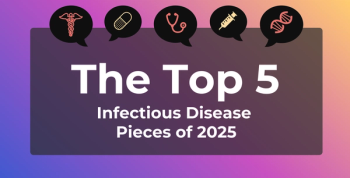
The Diabetes Healthcare Team: When Is a Specialist Needed?
Peter Salgo, MD: Let’s talk about managing diabetic macular edema. Now that we’ve talked about the progression to diabetic macular edema and know that there are some things we can wiggle in terms of the management of patients to prevent their getting there quickly.
But now we’ve got diabetic macular edema. Who are the members of the multidisciplinary team for patients with diabetes and their eye diseases? Who’s on that team? Is it just ophthalmologists? Or is there a larger, more all-inclusive group?
Rishi P. Singh, MD: It’s a large group. So frontline would be a general ophthalmologist or optometrist. They would be the person at a LensCrafters, or even at their own shop, that would screening eye disease at that point.
Peter Salgo, MD: So wait, you just said optometrist.
Rishi P. Singh, MD: Optometrist. So an optometrist is a person who goes through four years of optometry school, and not through medical school. The ophthalmologists go through four years of medical school, plus internship and residency, and potentially fellowship, as well.
Peter Salgo, MD: My sense is the optometrists come into contact with people far more broadly than ophthalmologists.
Rishi P. Singh, MD: There’s far more of them than there are any of us.
Peter Salgo, MD: There’s more LensCrafters.
Rishi P. Singh, MD: Absolutely.
Steven Peskin, MD, MBA, FACP: And more general ophthalmologists than retina subspecialists.
Peter Salgo, MD: And I want to get into that, too, because if you’re dealing with diabetic macular edema, which is a retinal issue, are the general ophthalmologists okay? Or do you really need a specialist such as a retina specialist to deal with this?
John W. Kitchens, MD: Well, being a retina specialist, I’m obviously going to say I think you need a retina specialist. But, when you think about what we take care of as retina specialists, 90% of the time it’s the basic three things: macular degeneration, vein occlusions, and diabetic retinopathy. So, we do it over and over and over. We’re not managing glaucoma, followed by cataracts, followed by diabetic retinopathy.
Steven Peskin, MD, MBA, FACP: You’re not doing Lasik?
John W. Kitchens, MD: We’re not doing Lasik surgery or anything such as that. But the big thing is that we do it over and over. And we have the ability to use all of the different medications, the lasers, and the latest technologies to take care of these patients.
Peter Salgo, MD: But when is a specialist absolutely needed? I think it’s fair to say that someone with more experience in a particular disease process is always going to be more experienced in that disease process. That’s part of logic. But does everybody need that expertise?
Rishi P. Singh, MD: I think the best way to put this is that for the general routine eye care issues, and for the early patient who’s getting screened and evaluated, the general ophthalmologist suits everything.
And, in fact, many of them have been trained to do lasers. Lasers were a general standard of care for many people and they might actually, in some areas, do some early treatments for diabetic retinopathy and diabetic macular edema.
But, when it comes to more severe patients such as patients who need surgery, potentially patients who don’t respond to treatments, they refer those patients to retina specialists like John.
Peter Salgo, MD: How do you know when to do that? Where’s the trigger point?
John W. Kitchens, MD: I personally think that when you see someone who has center-involved diabetic macular edema, and we can see this both clinically and with some of our imaging diagnostics, those patients really do better with retina specialists.
One of the problems with general ophthalmology when treating these patients is that in many instances, they get the treatments out of order.
So they may say, “You know what, I’m going to laser this first.” And we know from some of our recent studies that those patients who receive early laser may not do as well as those patients who receive anti-vascular endothelial growth factor therapy.
Peter Salgo, MD: And you know that. Some other practitioners may not know that, by virtue of the fact that that’s your area of expertise.
That being said, if we take a look at the map of the United States, it’s sort of like those AT&T and Verizon maps. The little red dots are everywhere. For optometrists, there’s a lot of red dots. For ophthalmologists, there are fewer red dots. And for retina specialists, even fewer red dots.
My guess, without having the data in front of me, but you might know, is that there’s going to be an access issue for a fair percentage of the American population. They’re going to be 50 miles, 100 miles, 200 miles from a retina specialist. How do you manage that?
John W. Kitchens, MD: We do have that problem in certain areas. And in those areas, the retina specialists have partnered with the general ophthalmologists to educate them on how to treat the patients. There’s correspondence with sending pictures or images of the scans and saying, “When do I treat this patient?”
Peter Salgo, MD: I was going to ask about that. Could you just send the scans real-time, telemedicine on the web?
John W. Kitchens, MD: Absolutely, you can. You could de-identify them and send them via text message to your retina specialist and say, “When should I treat this patient?”
And that’s really kind of critical for those patients. In Kentucky, especially eastern Kentucky where we take care of those patients, we go to see those patients. So we’ll travel two to three hours.
Peter Salgo, MD: You travel to them?
John W. Kitchens, MD: We travel to them. They have access issues, so we have to go to them.
Rishi P. Singh, MD: The retina has become a regional practice nowadays. It used to be that you had one office and you built the house that Babe built. You all come there, right?
And that doesn’t work anymore in our specialty. We have many people that have five, six, seven offices, and sometimes take planes to get to where they need to go in order to take care of patients. That’s pretty much a commonality in our field now.
Peter Salgo, MD: I must confess just for a moment that I’m taken aback. I’m flabbergasted, pleasantly so. You go out to where the meat is.
Steven Peskin, MD, MBA, FACP: We’re in a densely populated area—that being New Jersey with lots of medical subspecialists. That said, in the area of retina, we have seen this proliferation, pun-intended, of retina groups having multiple offices that go to where the persons are, rather than having somebody travel 25 miles, which in New Jersey might take an hour-and-a-half. So, those satellite offices make someone available a couple days a week in a certain office, or one day a week.
Rishi P. Singh, MD: And I think the biggest problem is we take care of the second-most geriatric practice other than geriatrics at this point. Our patients are old, and they’re not traveling, necessarily, to get to us. So we have to be where they can be and where they can get to us conveniently.
Peter Salgo, MD: But, on occasion, I must tell you, I do anesthesia in the Eye Institute. And as a group, all the pre-ops I see, that’s the oldest slice of America you’re going to see anywhere. The average age, it seems to me, is over 70, and the comorbidities are huge. They’re all hypertensive, and a fair number are diabetic. And they’re all in for some therapy.
I’m stuck on this fact that you travel. You have an office out somewhere else where you can be.
John W. Kitchens, MD: We have 11 offices.
Peter Salgo, MD: That’s wonderful.
John W. Kitchens, MD: And 60% of our patients in our practice come from satellites.
Peter Salgo, MD: It occurs to me this won’t happen without you guys or without some kind of reimbursement scheme that says, “Yeah, this is a good idea. We’re going to pay for that.”
Steven Peskin, MD, MBA, FACP: We don’t get down to the level of the subspecialist, such as the retina specialist versus the general ophthalmologist. We’re really relying on our clinicians to make those decisions. We’re not being proscriptive.
We talk about the primary care physicians as having that comprehensive role, the ‘comprehensivist.’ That comprehensivist will then send patients to a general ophthalmologist. They may go directly to a retina subspecialist for certain select patients because they know they’ve got retina disease. Or, they may rely on the general ophthalmologist to make that triage decision—that in-the-eye-ball triage decision. We really don’t stand in the way of that.
Again, we’re looking for overall outcomes for patients with diabetes. Eye-related disease in diabetes is included in that.
Peter Salgo, MD: We talked about the optometrist, ophthalmologist, and retina specialist. We haven’t heard the name ‘diabetes educator’ yet. That’s another tier; another level of potential interface with the system. Where does that come in? How is that reimbursed?
Rishi P. Singh, MD: I’ve actually spoken at the American Association of Diabetes Educators meeting a couple times in the past few years and it’s an amazing group of people. Nurse practitioners, and nurses who are diabetologists that focus on nutritional education around the diabetic patient, and care organizers. So this group really is the backbone and the coordinating group of that entire population. The primary care physician is one gatekeeper. But it comes more and more, I think, in managed care situations. These people are the people that are helping to run their overall subspecialty care in their lives.
Steven Peskin, MD, MBA, FACP: Yeah, we really emphasize team-based care. Some of our practices have a full or part-time diabetes educator. Some of the nurses that we help to pay for, we call ‘population care coordinators,’ get some training, sometimes provided by pharmaceutical companies, on motivational interviewing, teach back, and nutrition for diabetic persons.
So, there is a lot of focus on recognizing that the physician may not be the best person for certain aspects of the education and the motivation of patients. Diabetes educators and nurses that are trained as diabetes educators are very much a part of this notion of team-based care.
Peter Salgo, MD: And you’re paying for diabetes educators?
Steven Peskin, MD, MBA, FACP: We don’t routinely pay for diabetes educators. We pay certain value-based payments, which are called care coordination and outcomes based-payment.
Peter Salgo, MD: How do they get paid? Who pays it?
Steven Peskin, MD, MBA, FACP: So, for the care coordination payment, some of that is going toward those persons who don’t submit a current procedural terminology code for the services they are providing. There is enhanced compensation to reflect the fact that a high-performing practice may have a part-time diabetes educator or have one of the nurses who is trained as a diabetes educator. Sometimes we do actually see some of the pharmaceutical companies that will provide diabetes educators as an adjunct as well.
Peter Salgo, MD: Let me see if I understand what you’re saying. You’re not paying them directly. They’re not submitting a current procedural terminology code to you. So what you’re doing is you’re enhancing the payment to somebody who is, and hoping that flows through to the diabetes educator. Is that fair?
Steven Peskin, MD, MBA, FACP: Again, it’s not hoping that it flows through. It’s that we’re advancing team-based care. Diabetes education is a part of that. We can certainly debate who is the best person to provide that education.
Is a registered nurse without a formal designation as a diabetes educator able to do that as well? That’s debatable. If he or she then obtains that certification as a certified diabetes educator, that would indicate a certainly level of proficiency that is associated with that designation.
Newsletter
Stay ahead of policy, cost, and value—subscribe to AJMC for expert insights at the intersection of clinical care and health economics.








































